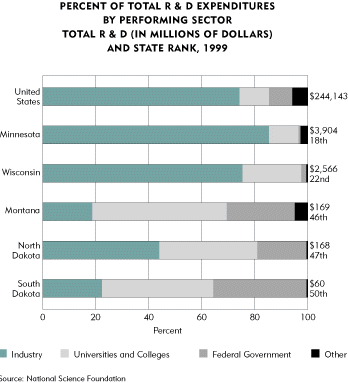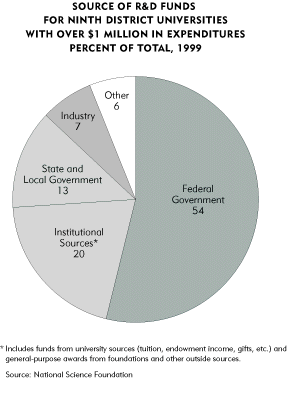Whether research and development (R&D) is performed by industry, universities or the federal government, R&D spurs advancements in science and eventually leads to new products.
The role of publicly funded research is unique compared to research conducted by the private sector. For example, the role of public universities is to focus on basic, or fundamental, research—specifically, research that the private sector wouldn't produce on its own. In turn, research conducted by industry primarily focuses on innovations that can be patented and made into marketable products. (See Opinion column for more discussion on the role of a research university.)
Minnesota and Wisconsin are home to major research universities, with budget expenditures that annually rank among the top 15 universities in the nation. However, in both states R&D is primarily performed by industry, which is similar to the U.S. average. In contrast, Montana, North Dakota and South Dakota have some of the smallest R&D expenditure levels in the country, according to National Science Foundation statistics. South Dakota ranks last in the nation overall. However, publicly funded research by universities and the federal government comprise a larger share of total R&D in these states. Montana has the highest level of R&D conducted by the federal government in the district.

Nationally, California has the highest level of R&D expenditures in the nation at $48 billion in 1999, followed by Michigan ($19 billion) and New York ($14 billion).
The Ninth District is home to 13 universities, each with over $1 million in R&D expenditures. They range from the University of Minnesota, with a budget of over $370 million that spans a wide range of fields from medical sciences to economics, to the University of Wisconsin-La Crosse with just over a $1 million R&D budget split between biological sciences and sociology.
The fields that top the R&D budgets at district universities are diverse and often reflect the predominant industries in their area. Public universities historically have conducted research that addresses questions of scientific theory and technology faced by local industry.
Engineering is the top field at four universities, including Montana Tech's metallurgical engineering research in the mining area around Butte. Just as agriculture has a large presence in the district, agricultural sciences is the top field at three universities and has high budget levels at several others. At the University of Minnesota, medical sciences comprise 40 percent of R&D expenditures, consistent with the strong presence of the medical equipment industry in the Minneapolis-St. Paul metro area.

Universities receive funding from federal and state governments, industry and institutional sources. The district's top 13 universities receive 54 percent of R&D funding from the federal government, followed by 20 percent from institutional sources, which include funds from university sources (tuition, endowment income, gifts, etc.) and general-purpose awards from foundations. About 13 percent of R&D funding comes from state and local governments and 7 percent from industry.





